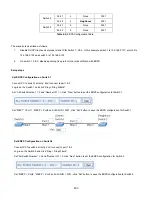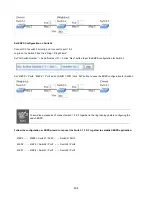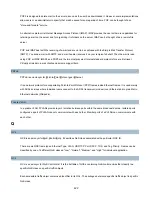
416
HTTP
HTTP is an acronym for
H
ypertext
T
ransfer
P
rotocol. It is a protocol that used to transfer or convey information on the
World Wide Web (WWW).
HTTP defines how messages are formatted and transmitted, and what actions Web servers and browsers should take in
response to various commands. For example, when you enter a URL in your browser, this actually sends an HTTP
command to the Web server directing it to fetch and transmit the requested Web page. The other main standard that
controls how the World Wide Web works is HTML, which covers how Web pages are formatted and displayed.
Any Web server machine contains, in addition to the Web page files it can serve, an HTTP daemon, a program that is
designed to wait for HTTP requests and handle them when they arrive. The Web browser is an HTTP client, sending
requests to server machines. An HTTP client initiates a request by establishing a Transmission Control Protocol (TCP)
connection to a particular port on a remote host (port 80 by default). An HTTP server listening on that port waits for the
client to send a request message.
HTTPS
HTTPS is an acronym for
H
ypertext
T
ransfer
P
rotocol over
S
ecure Socket Layer. It is used to indicate a secure HTTP
connection.
HTTPS provide authentication and encrypted communication and is widely used on the World Wide Web for
security-sensitive communication such as payment transactions and corporate logons.
HTTPS is really just the use of Netscape's Secure Socket Layer (SSL) as a sublayer under its regular HTTP application
layering. (HTTPS uses port 443 instead of HTTP port 80 in its interactions with the lower layer, TCP/IP.) SSL uses a
40-bit key size for the RC4 stream encryption algorithm, which is considered an adequate degree of encryption for
commercial exchange.
I
ICMP
ICMP is an acronym for
I
nternet
C
ontrol
M
essage
P
rotocol. It is a protocol that generated the error response, diagnostic
or routing purposes. ICMP messages generally contain information about routing difficulties or simple exchanges such
as time-stamp or echo transactions. For example, the PING command uses ICMP to test an Internet connection.
IEEE 802.1X
IEEE 802.1X is an IEEE standard for port-based Network Access Control. It provides authentication to devices attached
to a LAN port, establishing a point-to-point connection or preventing access from that port if authentication fails. With
802.1X, access to all switch ports can be centrally controlled from a server, which means that authorized users can use
Summary of Contents for NS4750-24S-4T-4X
Page 1: ...NS4750 24S 4T 4X User Manual P N 1702826 REV 00 01 ISS 14JUL14 ...
Page 56: ...56 Figure 4 2 7 Privilege Levels Configuration Page Screenshot ...
Page 110: ...110 Figure 4 4 6 Mirror Configuration Page Screenshot ...
Page 117: ...117 Figure 4 5 4 LACP Port Configuration Page Screenshot ...
Page 174: ...174 Figure 4 7 10 MST1 MSTI Port Configuration Page Screenshot ...
Page 180: ...180 Figure 4 8 2 Multicast Flooding ...
Page 249: ...249 Figure 4 9 18 Voice VLAN Configuration Page Screenshot ...
Page 271: ...271 Counter Counts the number of frames that match this ACE ...
Page 281: ...281 Figure 4 11 4 Network Access Server Configuration Page Screenshot ...
Page 315: ...315 ...
Page 328: ...328 ...
Page 335: ...335 ...
Page 346: ...346 Figure 4 14 1 LLDP Configuration Page Screenshot ...
Page 350: ...350 Figure 4 14 2 LLDP MED Configuration Page Screenshot ...
Page 372: ...372 Figure 4 16 1 Loop Protection Configuration Page Screenshot ...














































